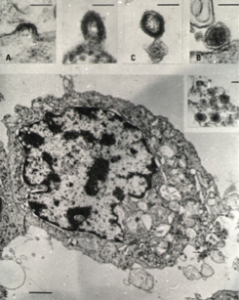Deadly, But Largely Unknown: GVN Spurs Efforts to Combat HTLV-1
Deadly, But Largely Unknown: GVN Spurs Efforts to Combat HTLV-1

As reported in PNAS by Poiesz et al. in 1980, images A-D show HTLV-I in the stages of budding and image E shows an ATL leukemic cell.
Thirty-eight years ago, Dr. Robert Gallo and his colleagues discovered Human T-cell Leukemia Virus 1 (HTLV-1), the first known human retrovirus and the first virus shown to cause cancer. This breakthrough is perhaps best known because it led another momentous discovery, the identification of HIV.
But HTLV-1 itself causes harmful, often lethal diseases such as adult T-cell leukemia (ATL) and HTLV-1 associated myelopathy/tropical spastic paraparesis (HAM/TSP) and affects an estimated 10-20 million people worldwide. Up to ten percent of the millions infected with HTLV-1 develop debilitating and sometimes deadly diseases associated with the virus. Despite this, the virus has not received the attention it deserves.
“HTLV-1 is underrecognized and underappreciated,” says Dr. Gallo, who is the co-founder and the scientific director of the GVN and director of the Institute of Human Virology (IHV) at the University of Maryland School of Medicine. “When HIV came along we focused our attention on that epidemic, but HTLV-1 remains a strong threat to global health. Now it’s time to refocus our energy on HTLV-1.”
Effective, Proven Intervention Strategies Need to Be Promoted
HTLV-1 is transmitted through the same routes as HIV-1 — including unprotected sex, breastfeeding, needle sharing, blood transfusion and organ transplantation. Most people with HTLV-1 don’t know of their infection, or that they are transmitting it to others.
“HIV and hepatitis are serious public health problems, and they’ve deserved the attention they’ve gotten. But HTLV-1 needs the same high level of concern and funding,” says Fabiola Martin, MD, MDRes, FRCP, FHEA, a member of the GVN HTLV-1 task force, and a specialist in sexual health, HIV and HTLV medicine. “The suffering caused by HTLV-1 has been underplayed for decades because, unfortunately, it has had a much lower profile internationally than other viruses and it has tragically often been seen as a harmless virus.”
HTLV-1’s transmission can be prevented in the same way as other blood borne and sexually transmitted viruses such as HIV-1 and hepatitis B and C. While global investment and proactive public health interventions have helped prevent and treat both HIV-1 and hepatitis, efforts to control HTLV-1 have lagged far behind. This means that thousands of cases of HTLV-1 and associated diseases go undiagnosed each and every year. “What is most unsettling,” says Dr. Martin, “is that the transmission of HTLV-1 is very easily and effectively prevented, but this hasn’t been promoted. All we need is the determination and concentrated international effort to eradicate HTLV-1, just like HCV and HIV.”
HTLV-1 Affects People Around the World
HTLV-1, which originated from non-human primates, appears to have existed for thousands of years. It tends to be concentrated in families because of the way it’s sexually transmitted from partner to partner and through breastfeeding from mother to child. Indigenous communities in Central Australia have one of the highest infection rates: In a hospital-based cohort study, 48 percent of indigenous people tested positive for HTLV-1. High rates also exist in Japan, Brazil, Iran, Romania, Peru, Central African Republic, Gabon, Nigeria, Jamaica and other Caribbean islands. Rates in many parts of the world remain unknown because of lack of testing.
Though not as prominent in the Europe and the United States, HTLV-1 rates maybe on the rise in as travel and global migration has become much more prevalent in recent decades. Researchers estimate that thousands of people live with the virus in the UK, France and United States.
GVN Focuses Renewed Attention on HTLV-1

Dr. Robert Gallo leads a panel discussion on the status of HTLV-1 research during the 9th International GVN Meeting in Melbourne.
In its efforts to foster renewed attention to the virus, GVN created the HTLV-1 Task Force. More recently, in September 2017 at its 9th International Meeting in Melbourne, Australia, GVN sought to highlight the importance of combating HTLV-1. In a May 10, 2018 open letter to World Health Organization (WHO) Director-General Elect Dr. Tedros Ghebreyesus, the GVN HTLV-1 Task Force, led on this initiative by Dr. Martin and Dr. Gallo in collaboration with patient advocates and international HTLV-1 experts, asked the WHO to do more to fight the virus and proposed several public health intervention strategies to prevent its transmission. Lancet published a shorter version of the letter, Time to eradicate HTLV-1: an open letter to WHO, May 10th online and in its May 12th issue.
In its letter to WHO, the GVN HTLV-1 task force recommended several distinct intervention strategies against the transmission of HTLV-1:
- Routine HTLV-1 testing in sexual health clinics should be available to all attendees.
- Promote CMPC: Counsel & Monitor HTLV-1 positive patients, notify Partners and promote Condom usage. This strategy also supports HTLV-1 positive parents to test their children for HTLV-1.
- Testing of donors and not using products potentially infected with HTLV.
- Routine antenatal care testing and advise against breastfeeding by mothers who are HTLV-1 positive where safe, alternative methods of infant feeding are available.
- Promote HTLV-1 testing and provide free safe needles through needle exchange programs together with CMPC promotion.
- All people diagnosed with HTLV-1 need to be followed up medically and monitored clinically, immunologically and virologically to be able to access treatment promptly.

Dr. Damian Purcell of the Doherty Institute, Dr. Lloyd Einsiedel of the Baker Institute, Dr. Yutaka Tagaya of the Institute of Human Virology at the University of Maryland School of Medicine, Dr. Charles Bangham of Imperial College London, Dr. William Hall of University College Dublin, Toshi Watanabe of St. Marianna University School of Medicine, David Yurick – a PhD student, and Dr. Fabiola Martin of University of Queensland, join a group photo following discussions on the idea of an open letter to WHO during the 9th International GVN Meeting.
To promote these strategies to healthcare professionals and patients around the globe, the Open Letter asks the WHO to collaboratively develop a HTLV-1 Fact Sheet with clear advice about the dangers of HTLV-1 and its associated diseases and effective ways to prevent transmission. “We are trying to make people aware of what can be done for people living with HTLV-1 and that there are effective ways to prevent transmission,” says Dr. Martin. “To do that, it’s really important that we offer our support and expertise to WHO.” Currently there is no international guidance for HTLV-1, but a WHO HTLV-1 Fact Sheet could provide that.
In addition, the authors recommend that WHO create an International Classification of Disease Code (ICD) for HAM/TSP. Despite its distinct etiology and distinctive pattern there is no ICD code for HAM/TSP. The lack of an ICD code is surprising, given the fact that the has been linked to HTLV-1 for more than three decades. An ICD code will help reduce the under-diagnosis and under-reporting of HTLV-1 associated diseases.
Prevention Efforts Have Significant Results
HTLV-1 prevention strategies are currently being implemented in a few countries, though inconsistently, most likely because of a lack international consensus. Japan is now the only country offering HTLV-1 screening for all pregnant women. To promote research, the country is also providing grants for clinical trials and patient registries focused on ATL and HAM/TSP. In Brazil, HTLV-1 screening for pregnant women is recommended, but not always provided in all parts of the country.
Such efforts have had significant results. Since Japan introduced HTLV-1 screening for pregnant women, mother-to-child transmission rates have dropped sharply. Martinique has seen a major reduction in HAM/TSP since it began screening for pregnant women and blood donors.
The promotion of these prevention strategies, along with education of healthcare professionals and the public about the virus, would help to significantly reduce the HTLV-1 infection and disease rates. “This destructive and lethal virus is causing much devastation in communities with high prevalence,” says Dr. Gallo, “But it’s just not on the radar – not on the public’s radar, and not on the public health radar. That has to change. It’s just too big of a problem.”

Participants of the 9th International GVN Meeting in Melbourne, Australia gather for a group photo.
